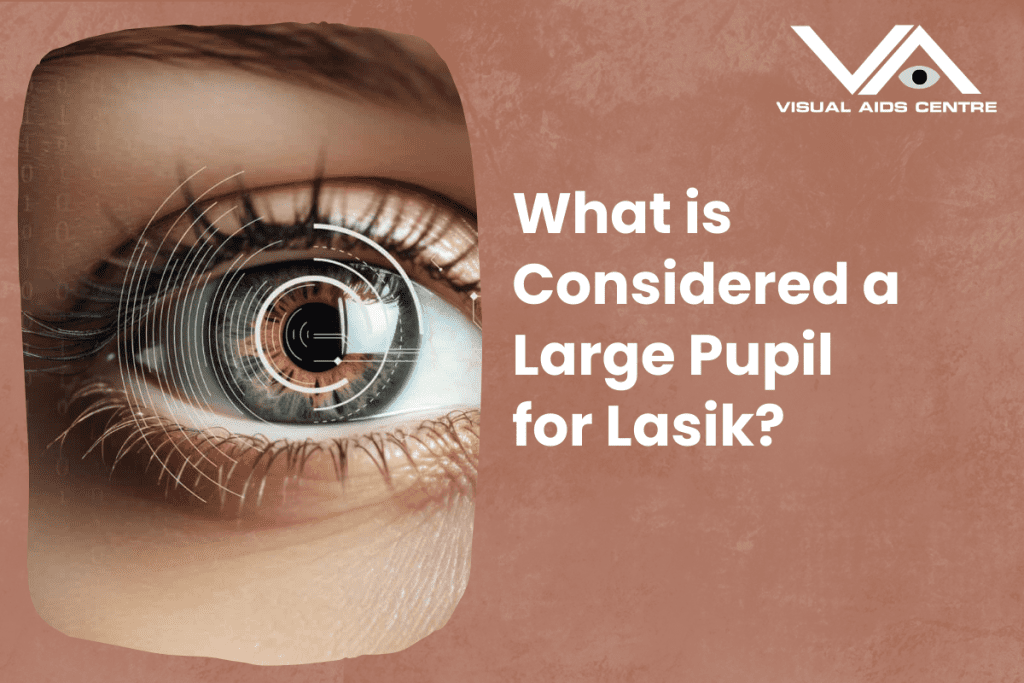Table of Contents
ToggleIntroduction
When considering LASIK surgery, potential candidates might come across various factors that could impact their suitability for the procedure.
Among these factors, pupil size often becomes a point of discussion.
Understanding what constitutes a large pupil for LASIK is crucial for those considering this life-changing surgery.
This blog aims to demystify the topic by providing detailed, research-backed information to help both LASIK candidates and ophthalmology enthusiasts make informed decisions.

Understanding Pupil Size
The pupil, a black circular opening at the center of the iris, allows light to enter the eye. Its size adjusts according to lighting conditions—contracting in bright light and dilating in darkness.
Pupil size can also vary based on age, emotional state, and certain medications. Under normal lighting conditions, the average pupil size typically ranges from 2 to 4 millimetres, while in darkness, it can dilate to 7 or 8 millimetres.
Why Pupil Size Matters in LASIK?
Pupil size is a critical consideration in LASIK surgery because it affects how light enters the eye and is focused onto the retina.
A mismatch between the treated corneal area and the pupil size can lead to visual disturbances, particularly in low-light conditions.
Common issues include halos, glare, and starbursts, which can significantly impact the quality of vision, especially at night.
What is Considered a Large Pupil?
In the context of LASIK, a “large” pupil typically refers to one that measures 7 millimetres or more in dim lighting conditions. However, this threshold can vary among surgeons and clinics. It’s essential to note that having large pupils does not automatically disqualify someone from undergoing LASIK. Instead, it necessitates a more thorough examination and possibly the use of advanced techniques to ensure optimal outcomes.
How Pupil Size is Measured
Ophthalmologists use a device called a pupillometer to measure pupil size accurately. This instrument provides precise readings under various lighting conditions, which are crucial for planning the LASIK procedure. Measurements are usually taken in both normal and dim lighting to understand the range of pupil dilation.
Factors Influencing Pupil Size
Several factors can influence pupil size, including:
- Age: Younger individuals tend to have larger pupils than older adults.
- Lighting Conditions: Pupils dilate in low light and constrict in bright light.
- Medications: Some drugs, such as those for treating glaucoma or certain antidepressants, can affect pupil size.
- Genetics: Pupil size can be hereditary, with some people naturally having larger or smaller pupils.
Risks Associated with Large Pupils
Candidates with large pupils may face a higher risk of post-LASIK visual disturbances. Here are some potential issues:
Halos
Halos manifest as radiant rings encircling light sources, becoming particularly prominent at night. They occur when the pupil dilates beyond the treated corneal area, causing light to scatter.
Glare
Glare refers to the difficulty of seeing in bright light, often accompanied by discomfort. Night driving can be particularly challenging.
Starbursts
Starbursts are radiating lines that appear around lights, making them look like stars. This phenomenon is more pronounced in low-light conditions and can be distracting and uncomfortable.
Mitigating Risks with Advanced Techniques
Modern LASIK technology has evolved to address the challenges posed by large pupils. Surgeons can now employ several advanced techniques to minimize risks and improve outcomes:
Wavefront-Guided LASIK
Wavefront-guided LASIK uses detailed measurements of how light waves travel through the eye to create a customized treatment plan. This technology corrects higher-order aberrations, minimizing the occurrence of halos, glare, and starbursts.
Large Optical Zones
Surgeons can create larger optical zones during the LASIK procedure to ensure that the treated area covers the entire range of pupil dilation. This approach reduces the risk of visual disturbances in low-light conditions.
Custom Ablation Profiles
Custom ablation profiles tailor the laser treatment to the specific characteristics of the patient’s eye, including pupil size. This personalized approach enhances the precision of the surgery and minimizes side effects.
Consultation and Preoperative Assessment
A thorough preoperative assessment is crucial for LASIK candidates with large pupils. During the consultation, the surgeon will:
- Measure Pupil Size: Using a pupillometer to obtain accurate readings under various lighting conditions.
- Evaluate Corneal Thickness: Ensuring there’s sufficient tissue for a safe and effective procedure.
- Assess Overall Eye Health: Identifying any underlying conditions that could impact the surgery’s success.
- Discuss Expectations: Providing a realistic understanding of the potential outcomes and risks.
Next Steps
Understanding the implications of large pupils in LASIK surgery is crucial for making an informed decision. While large pupils can pose certain risks, advancements in LASIK technology have made it possible to mitigate these risks effectively. A comprehensive preoperative assessment and consultation with an experienced LASIK surgeon can help tailor the procedure to individual needs, ensuring the best possible outcomes.
Ready to take the next step? Schedule a consultation with your ophthalmologists today and explore how LASIK can transform your vision. Don’t let pupil size hold you back from experiencing a clearer, sharper vision.
By understanding what constitutes a large pupil for LASIK and how modern techniques can address associated risks, candidates can make informed decisions about their eye health. This comprehensive guide aims to provide valuable insights and encourage those considering LASIK to explore their options confidently.













